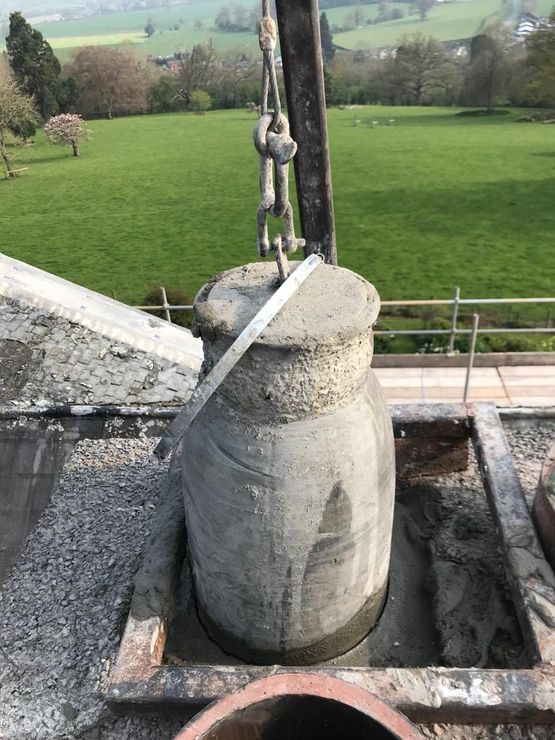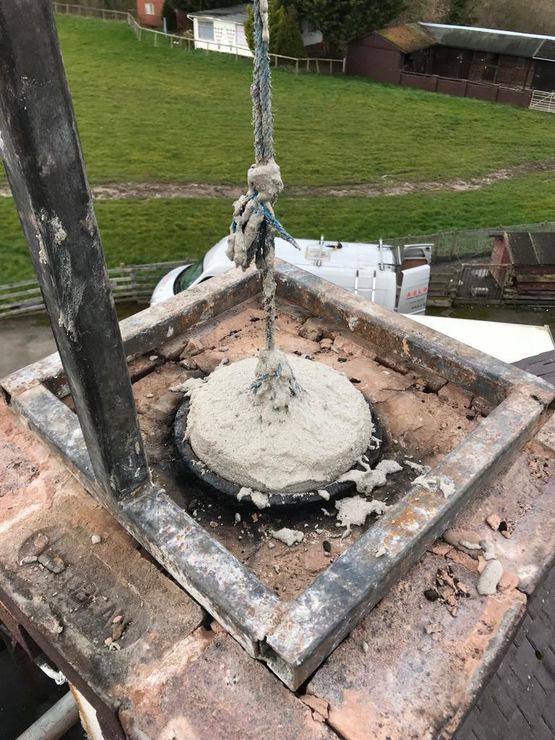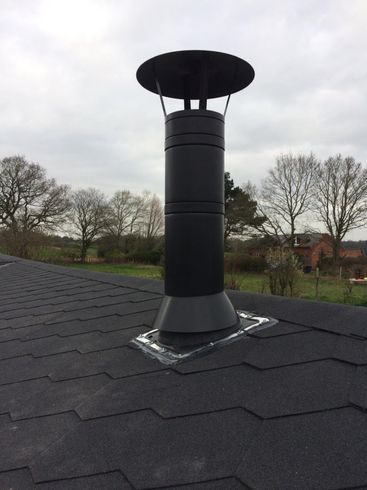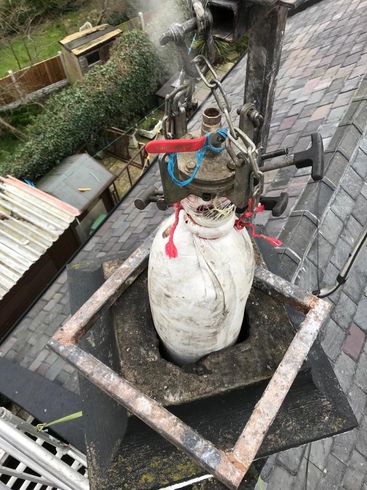Chimney Flue Linings
The chimney flue linings experts in Chester

A & L Parry Ltd has a history of top-notch chimney flue linings installations. There are many reasons for lining a chimney. These reasons include:
- Your flue is leaking fumes and/or smoke into other parts of your house.
- Tar is leaking through the chimney walls, leading to staining of the building.
- The flue is too large for the type of appliance or fire in use.
- The flue is too cold. This can occur if it is placed on an outside wall and is not properly drawing.
- The old chimney flue lining surface is rough and eroded. This causes frictional resistance to gas flow, leading to poor updraft.
We also serve our customers in Wales, North Wales, Cheshire and Shropshire.
A wide range of chimney flue linings

At A & L Parry Ltd, we stock a variety of the world’s best chimney flue linings. Consult with our experts at our Chester office and we will help you make the decision that’s best for your needs.
- Furan Flex - Furan Flex is based on a glass fibre-reinforced thermosetting resin, as strong as stainless steel. However it is much more corrosion resistant than other methods, and serves as a permanent flue area fixture. Normally, a 25-year guarantee is available.
- Thermocrete - Thermocrete is an environmentally-friendly, gas-tight chimney lining that can be easily installed. It is efficient, safe and durable and can be set up within a single day. Its patented system can only be installed by licensed engineers, who we have at our disposal. Normally, a 25-year guarantee is available.
- Eldfast - This chimney relining involves the application of a kind of ceramic material. The chimney’s base is plugged, and a cable is used to hold it in position. Liquid lining material is poured into the chimney, sealing any defects and cracks while leaving a smooth coating. Normally, a 25-year guarantee is available.
- Stainless Steel - Stainless steel chimney flue lining is another excellent option for your household dependent on a variety of factors. It offers good heat protection and a long lifespan.
Methods of Lining

Several methods are available for inserting a lining into an existing flue. A brief list of these is as follows:
1. Rigid sections of a clay or refractory liner installed by cutting into the flue wall or by lowering down form the top of the chimney.
2. Insulating concrete pumped in around an inflatable forma by a specialist contractor.
3. Flexible metal liner in a continuous length lowered down the chimney .
4. Spray on coating by specialist contractor.
5. Ceramic coating by a specialist contractor.
All of these methods have some advantages and some draw backs. Their suitability will depend on individual circumstances. Good professional advice on the most appropriate system is essential.
Reasons for lining
There are a number of reasons why and old chimney may need lining
1. The flue is leaking smoke and fumes into other rooms or parts of the building
2. Condensates or tar are seeping through the chimney walls causing staining, either inside or outside the building (a common problem with wood burning stoves)
3. The flue is much too large for the type of fire or appliance being used.
4. The flue is to cold, particularly if an outside wall, and is not drawing properly.

THERMOCRETE
PUMPED REFRACTORY CONCRETE
We use only quality Thermocrete
products.
This system consists of lowering a rubber forma or ‘sausage’ down the chimney, inflating it slightly, and then pumping in a lightweight refractory concrete mix, When the concrete has set, the former is deflated and withdrawn leaving a smooth flue filling all voids and cracks strengthening the chimney structure. The installation is permeant and if properly installed and regularly swept should last the life of the building.
SPRAY ON LINING
THERMOCRETE
This system is applied by passing a revolving spray head slowly through the old flue which applies a special coating to the flue walls. The spray head is capable of negotiating bends and the rate of passage through the flue determines the thickness of the coating usually 7mm. This system is carried by specialist skilled contractors. The flue is thoroughly scoured clean first and is inspected with a closed circuit TV camera to check all is ok . A video recording can be made for reference purposes.
CERAMIC COATING
ELDFAST SYSTEM
The most recent development in chimney relining involves applying a ceramic type lining material, The base of the chimney is plugged and held in position by a cable attached to a winch on the chimney top. Liquid lining material is poured into the chimney to completely cover the plug which is then pulled to the top of the flue . The plug forces the lining material onto the internal surface sealing any cracks and fissures and leaving a smooth coating. Several coats can be added if necessary. The installation Is permanent and if swept regularly should last the life of the building.
FLEXIBLE METAL LINERS
There are to distinct types of flexible liners available and it is very important to distinguish between them.
SOLID FUEL LINER
This is a double skinned liner made from and extremely high quality stainless steel, Usually 904L or 316Ti (Titanium) grade. It is smooth on the inside , corrugated on the outside and must be installed the correct way up. It is specifically designed for relining flues for solid fuel and wood. Flexible liners are relatively easy and clean to install. They are usually drawn down the chimney by rope from the top and will pass round most bends without opening up the flue.
GAS AND OIL FLUE LINERS
A light gauge single skin liner, Only suitable for closed gas fires and boilers, some inset fuel effect gas fires and kerosene oil appliances. It should never be used with solid fuel or wood burning appliances.
RIGID REFRACTORY LINER
This is the most traditional method of lining using refractory concrete, clay or ceramic liners of the same type commonly used in a new build. There are also some pumice liners designed specifically for relining. The Chimney has to be opened at frequent intervals to insert the liners, essential if there are bends in the flue. The resulting dust, mess and subsequent redecorating are not popular with the householder.

TWIN WALL FLUE SYSTEM
(Factory Made Chimney)
Twin Wall Flue Pipe is designed to clip together chimney system that can be used to safely take the combustion gases from a wood burning stove and outside to the atmosphere. Twin Wall Flue is is a metal insulated with approximately an inch of insulation (two layers of stainless steel with insulation between them)
Twin Wall Systems are used with all types of appliances (ie stoves when it is fitted into a property were there is no masonry chimney) It can run internally or externally and it achieves higher temperatures due to the layer of insulation to allow the flue to preform correctly and efficiently
FURAN FLEX LINGING SYSTEM
Furan Flex is based on a glass fibre reinforced thermosetting resin, which is as strong as steel when set, but with much better corrosion resistance than other methods.
There are two types of Furan Flex Liner (Black is for Gas, Oil, Air Conditioning, Drainage Ducts) (Red is for Solid Fuel, Open Fire, Kitchen Extractors).
A furan flex tube consists of three layers which when delivered form the manufacturer is a soft flexible tube folded into a compact pack. The furan flex liner comes deflated it has to be inserted into the flue before being inflated to the flue size once the liner is in place a steam generator is attached and it is heated. Once Steamed and hardened the furan flex liner is as strong as steel liners and provides a perfect gas tight lining ready to use. The installation process of the furan flex is very clean and none intrusive with most installations completed within one day. The furan flex liners is a permanent fixture.
Contact us for a free quote
Contact us
Thank you for contacting us.
We will get back to you as soon as possible.
We will get back to you as soon as possible.
Oops, there was an error sending your message.
Please try again later.
Please try again later.












